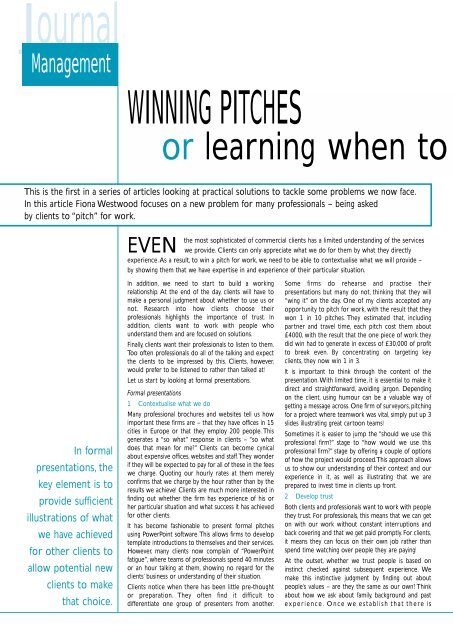OF THE LAW SOCIETY OF SCOTLAND - The Journal Online
OF THE LAW SOCIETY OF SCOTLAND - The Journal Online
OF THE LAW SOCIETY OF SCOTLAND - The Journal Online
You also want an ePaper? Increase the reach of your titles
YUMPU automatically turns print PDFs into web optimized ePapers that Google loves.
<strong>Journal</strong><br />
Management<br />
WINNING PITCHES<br />
or learning when to<br />
This is the first in a series of articles looking at practical solutions to tackle some problems we now face.<br />
In this article Fiona Westwood focuses on a new problem for many professionals – being asked<br />
by clients to “pitch” for work.<br />
In formal<br />
presentations, the<br />
key element is to<br />
provide sufficient<br />
illustrations of what<br />
we have achieved<br />
for other clients to<br />
allow potential new<br />
clients to make<br />
that choice.<br />
EVEN<br />
the most sophisticated of commercial clients has a limited understanding of the services<br />
we provide. Clients can only appreciate what we do for them by what they directly<br />
experience.As a result, to win a pitch for work, we need to be able to contextualise what we will provide –<br />
by showing them that we have expertise in and experience of their particular situation.<br />
In addition, we need to start to build a working<br />
relationship. At the end of the day, clients will have to<br />
make a personal judgment about whether to use us or<br />
not. Research into how clients choose their<br />
professionals highlights the importance of trust. In<br />
addition, clients want to work with people who<br />
understand them and are focused on solutions.<br />
Finally, clients want their professionals to listen to them.<br />
Too often professionals do all of the talking and expect<br />
the clients to be impressed by this. Clients, however,<br />
would prefer to be listened to rather than talked at!<br />
Let us start by looking at formal presentations.<br />
Formal presentations<br />
1 Contextualise what we do<br />
Many professional brochures and websites tell us how<br />
important these firms are – that they have offices in 15<br />
cities in Europe or that they employ 200 people. This<br />
generates a “so what” response in clients – “so what<br />
does that mean for me?” Clients can become cynical<br />
about expensive offices, websites and staff.<strong>The</strong>y wonder<br />
if they will be expected to pay for all of these in the fees<br />
we charge. Quoting our hourly rates at them merely<br />
confirms that we charge by the hour rather than by the<br />
results we achieve! Clients are much more interested in<br />
finding out whether the firm has experience of his or<br />
her particular situation and what success it has achieved<br />
for other clients.<br />
It has become fashionable to present formal pitches<br />
using PowerPoint software.This allows firms to develop<br />
template introductions to themselves and their services.<br />
However, many clients now complain of “PowerPoint<br />
fatigue”, where teams of professionals spend 40 minutes<br />
or an hour talking at them, showing no regard for the<br />
clients’ business or understanding of their situation.<br />
Clients notice when there has been little pre-thought<br />
or preparation. <strong>The</strong>y often find it difficult to<br />
differentiate one group of presenters from another.<br />
Some firms do rehearse and practise their<br />
presentations but many do not, thinking that they will<br />
“wing it” on the day. One of my clients accepted any<br />
opportunity to pitch for work, with the result that they<br />
won 1 in 10 pitches. <strong>The</strong>y estimated that, including<br />
partner and travel time, each pitch cost them about<br />
£4000, with the result that the one piece of work they<br />
did win had to generate in excess of £30,000 of profit<br />
to break even. By concentrating on targeting key<br />
clients, they now win 1 in 3.<br />
It is important to think through the content of the<br />
presentation. With limited time, it is essential to make it<br />
direct and straightforward, avoiding jargon. Depending<br />
on the client, using humour can be a valuable way of<br />
getting a message across. One firm of surveyors, pitching<br />
for a project where teamwork was vital, simply put up 3<br />
slides illustrating great cartoon teams!<br />
Sometimes it is easier to jump the “should we use this<br />
professional firm?” stage to “how would we use this<br />
professional firm?” stage by offering a couple of options<br />
of how the project would proceed.This approach allows<br />
us to show our understanding of their context and our<br />
experience in it, as well as illustrating that we are<br />
prepared to invest time in clients up front.<br />
2 Develop trust<br />
Both clients and professionals want to work with people<br />
they trust. For professionals, this means that we can get<br />
on with our work without constant interruptions and<br />
back covering and that we get paid promptly. For clients,<br />
it means they can focus on their own job rather than<br />
spend time watching over people they are paying!<br />
At the outset, whether we trust people is based on<br />
instinct checked against subsequent experience. We<br />
make this instinctive judgment by finding out about<br />
people’s values – are they the same as our own? Think<br />
about how we ask about family, background and past<br />
experience. Once we establish that there is










